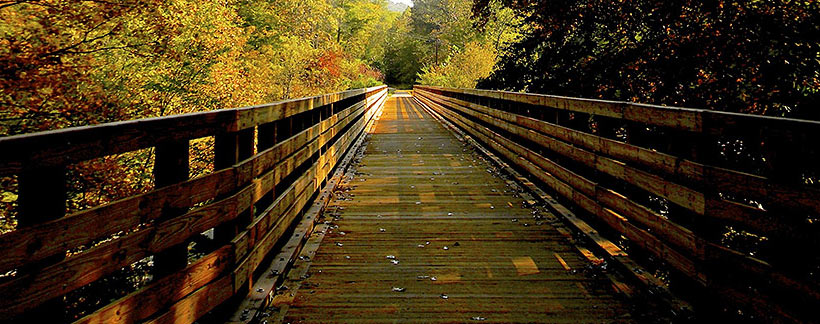The “Trail-Building Toolkit” is an interactive Rails-to-Trails Conservancy (RTC) website, and is a valuable resource for understanding the process of going from acquisition to designing and building rail-trails.
http://www.railstotrails.org/build-trails/trail-building-toolbox/
In addition, the RTC has free Reports to download that give specific guidance on rail-trail planning, development, and maintenance. http://www.railstotrails.org/resource-library/
Reason for Rail-Trails
The existence for rail-trails is intertwined with the history of railroads and their decline. Faced with the loss of railroad corridors and inability to return to future rail use, Congress enacted the Railbanking option which is a condition allowing a railroad to “bank” a corridor for future rail use through interim conversion to a trail.
What Is Railbanking?
Railbanking is a method by which corridors that would otherwise be abandoned can be preserved for future rail use through interim conversion to a trail. Established in 1983 as an amendment to Section 8(d) of the National Trails System Act, the railbanking statute allows a railroad to remove all of its equipment, with the exception of bridges, tunnels, and culverts, from a corridor, and to turn the corridor over to any qualified private organization or public agency that has agreed to maintain it for future rail use. This property transfer precludes abandonment.
Railroad companies have the right to re-establish rail service on a railbanked corridor. Should that occur, the trail managing agency ordinarily is entitled to fair market compensation from the railroad that wants to re-establish rail service. However, to avoid disputes, this issue should be specifically addressed as a contingency in the initial contract with the abandoning railroad.
Railbanking protects the corridor from adjacent property owner claims, allows interim trail use and preserves the entire corridor intact for possible future rail use.
Notice of Abandonment- Sign Up for Alerts
First, you must determine if the corridor is, or is in the process of, being abandoned. RTC monitors requests filed with the Surface Transportation Board (STB) and notifies communities—including trail advocates and public officials—of impending abandonments.
This makes it possible for these individuals to file a railbanking request, in which case the corridor is not considered abandoned and can be sold, leased or donated to a trail manager without reverting to adjacent landowners.
Sign Up for Early Warning Alerts on Railroad Abandonments–
https://secure2.convio.net/rtt/site/SSurvey?ACTION_REQUIRED=URI_ACTION_USER_REQUESTS&SURVEY_ID=10685
A railroad corridor is abandoned when rail service is discontinued, STB officially approves the abandonment, tariffs (pay schedules) are canceled and the railroad files an abandonment consummation notice with STB. Status of abandonment can be determined through the rail office of your state department of transportation or by contacting the railroad company. In these cases, the potential trail builder will need to research the corridor and contact the railroad to determine ownership of the corridor and the steps required for acquisition.
Inactive vs. Abandoned Lines
Inactive lines may still be owned by the railroad company and not have status as abandoned. Property acquisition often first requires researching property ownership.
If you discover that it is in private hands, negotiations may be more difficult but there are several options to negotiate with the owner such as purchase, easements, land donations, and leasing the land. Learn more at http://www.railstotrails.org/build-trails/trail-building-toolbox/acquisition/acquisition-methods/
Property Research
County property tax office
In West Virginia, there are primarily two active railroad companies-
CSX Inc.- Matt Coffing – CSX Real Property, Inc.
Manager – Trails and Natural Resources
Bldg. 1; Speed Code J915
6737 Southpoint Drive South, Suite 100, Jacksonville, FL 32216
Off. 904-279-4837 Fax. 904-245-3850
E-mail: Matthew_Coffing@csx.com
Norfolk Southern- Christopher Jones
Norfolk Southern Corporation
8000 Ravines Edge Court – Suite 100
Columbus, OH 43235
P: 614-438-6912 | F: 614-438-6939
WV State Rail Authority- Cindy Butler, Director
120 Water Plant Drive
Moorefield, WV 26836
Ph: 304-538-2305 ext. 223
Fax: 304-538-7474
Cell: 304-813-7775
Cindy.K.Butler@wv.gov
Negotiating Price with the Railroad: Property Appraisal
Several trail groups between 2010-2016 have split the cost of property appraisal with CSX after both CSX and the trail managers agreed to the independent appraiser. Depending on the size of property appraised and other factors, the appraisal costs will vary.
For one such trail, the Meadow River Rail-Trail, the appraiser was-
Jay Goldman, President
Goldman Associates, Inc.
1014 Bridge Road
P.O. Box 271
Charleston, WV 25321
(304) 343-5695
Fax (304) 343-5694
www.goldmanassociates.org
In the past, typically the railroad company and the trail managers hired separate appraisers and negotiated the value of the property. This could take many years and sometimes has stopped the acquisition process. Most existing rail-trails in WV did successfully negotiate with the railroad company in this manner, though it is becoming generally less recommended with this other option available.
